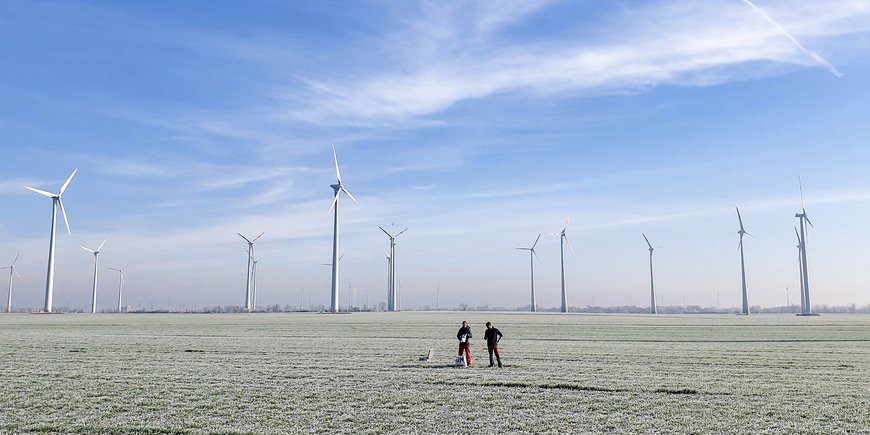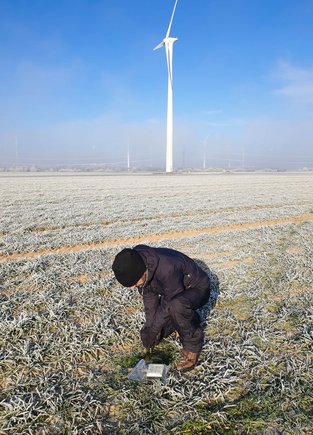Summary
Cities and their dense building stock are not only particularly at risk from earthquakes, they also have a significant influence on the propagation of seismic waves. The destructive surface waves can be affected and attenuated by regular building structures. This has now been shown for the first time in a study by a team led by Marco Pilz and Fabrice Cotton from the GFZ German Research Centre for Geosciences, using the example of a wind farm in Nauen near Berlin. The wind turbines can be regarded as elementary building blocks of so-called seismic metamaterials. Those artificially produced, usually regular structures strongly produce wavefield properties not being observed in free-field conditions. This metamaterial principle has already been demonstrated in optics and acoustics. The new study investigates the effects of man-made urban-scale structures on seismic waves – and thus also contributes to the ongoing debate about the Anthropocene. It has been published in the journal Frontiers in Earth Science.
Background: The metamaterial principle
One of the major challenges in earthquake engineering is to minimise the destructive effect of near-surface seismic waves on buildings, especially in cities. This results in a complex seismic wave field caused by the interaction of seismic waves and the building structures they cause to resonate.
How does urbanisation influence the propagation of seismic waves? And can these waves be controlled and deflected specifically designed building structures? This has already been well researched for light and sound: experiments with suitably structured materials have shown that light and sound waves can be channelled around an object. The object is no longer an obstacle and becomes virtually invisible to the waves – a kind of cloaking effekt.
Such artificial structures are called metamaterials. They are made up of many regularly arranged so-called resonators, which can be stimulated to vibrate and thus emit corresponding waves. Waves that hit the resonator structure from the outside are then be cancelled out in certain directions. In a certain wavelength range or frequency spectrum, the waves can thus be prevented from propagating.
The waveguiding properties of a metamaterial are determined by the size, spacing and other properties of the resonators. In particular, the structures typically have to be about half to a tenth as large as the wavelength to be influenced. This results in novel optical or acoustic properties that natural materials do not possess.
Metamaterials for seismic waves?
The idea of investigating the metamaterial phenomena observed in acoustics and optics on large spatial scales has been around for several years. Any dense, regular building stock can act like a metamaterial. This means, metamaterial like structures could influence the propagation of the seismic wave field after an earthquake, especially the surface waves, which have the greatest destructive potential for infrastructure and buildings. Previous studies have, for example, investigated the effects of regularly spaced trenches and boreholes, as well as forests.
As a first approximation to metamaterial-like qualities of urban landscapes, a team of researchers led by Marco Pilz and Fabrice Cotton from the GFZ German Research Centre for Geosciences in Potsdam has now investigated a regular arrangement of wind turbines. Together with colleagues from research institutions in Grenoble and Toulouse (France), the University of Potsdam and the Ludwig Maximilian University of Munich, they carried out measurements in a wind farm near Nauen to the west of Berlin. They set up a dense grit of more than 400 seismic stations in an area measuring 1.5 by 2.5 square kilometres and additional complementary technology like an optical fiber as well as rotational and barometric sensors. No earthquakes were artificially generated, but the natural seismic ground vibrations were detected, which lie in the same frequency range.
Buildings like wind turbines can significantly influence seismic waves, but are not an ideal metamaterial
“In our study, we have shown for the first time that tall buildings on the scale of a city neighbourhood can interact with each other, with the seismic wave field and also with the atmospheric pressure field. Our measurements demonstrate that the dense arrangement of wind turbines significantly reduces the strength of seismic waves in the frequency range of a few Hertz, which is of interest for earthquake-relevant civil engineering, but cannot cancel them out,” summarises Marco Pilz, scientist in the GFZ's ‘Seismic Hazards and Dynamic Risks’ section.
Basically, the following happens: The wind turbines constantly vibrate at certain resonance frequencies – just like a house does. As soon as a surface wave hits the wind turbine tower from a distance, the resonance frequency of which corresponds to the frequency of the seismic waves, a so-called secondary source of waves is created at this point. Because they oscillate out of phase, the resonant metamaterials are able to exert forces on the surrounding ground that are directed against the incoming ground motion and thus reduce its strength.
According to the researchers, the fact that the wind farm does not exhibit perfect metamaterial behaviour could also be due to the fact that the wind farm is not designed as a metamaterial: the wind turbines vary in height and weight and are not perfectly periodically positioned. Their vibration behaviour is complex. The rather soft and layered soil structure could also play a role.
Outlook: Study of urban structures and a basic understanding of the impact of human intervention on the Earth's landscapes as a contribution to the ongoing debate about the Anthropocene
“Our results can serve as the very first step for potential future applications with regard to the mitigation of seismic hazards in urban areas”, says Fabrice Cotton, co-author and head of the ‘Seismic Hazards and Dynamic Risks’ section at the GFZ and Professor of Seismology at the University of Potsdam.
However, the scientists’ focus extends beyond this singular effect of metamaterial-like properties: “Exemplified by the presence of a large number of wind turbines, we have demonstrated that urban areas possess novel wave propagation characteristics, thus emphasizing the transformative impact of human interventions on Earth's landscapes. We aim for a broader understanding of this, also as a contribution to the ongoing debate about the Anthropocene,” emphasises Cotton.
According to the researcher, the new results initiated a paradigm shift in our understanding of the urban environment: Cities are no longer mere collections of buildings and infrastructures, but emerge as dynamic entities with newly emerging properties, similar to complex metamaterials.
“Overall, this is a very challenging task which requires both, a certain humility in the face of the large number of unknown influencing factors and co-operation across the boundaries of disciplines,” says Cotton.
Original publication:
Pilz, M., Cotton, F. et al. Wind turbines as a metamaterial-like urban layer: an experimental investigation using a dense seismic array and complementary sensing technologies. Frontiers in Earth Science, 12, 1352027. DOI: 10.3389/feart.2024.1352027 https://doi.org/10.3389/feart.2024.1352027















![[Translate to English:] [Translate to English:] Abror Gafurov von dem Schriftzug "Welcome to Azerbaijan" und den UN und COP Logos](/fileadmin/_processed_/2/5/csm_2024_11_Baku_COP29_Abror_Gafurov_1042faec82.jpeg)


![[Translate to English:] Martin Herold standing in front of the library on the Telegrafenberg](/fileadmin/_processed_/c/d/csm_Martin_Herold_d385ee4dd9.jpeg)
![[Translate to English:] Many people are listening to a presentation in the GFZ lecture hall.](/fileadmin/_processed_/c/a/csm_1_Bild1_hell_b9c0e9f5ed.jpeg)






![[Translate to English:] Both scientists sitting on stools in front of a wall of books in the Telegrafenberg library](/fileadmin/_processed_/6/6/csm_Buiter_Castell_DORA_4_e87cb1ea18.jpeg)
![[Translate to English:] Gruppenbild mit 4 Personen](/fileadmin/_processed_/8/d/csm_20241017_GFZ-Emmerman-Medal-005_web_reinhardtundsommer_21a414fa4a.jpeg)






![[Translate to English:] Ice landscape with five red tents](/fileadmin/_processed_/8/9/csm_Zeltlager_auf_dem_Eis_Urheberin_Jenine_McCutcheon_5ced2d523b.jpeg)


